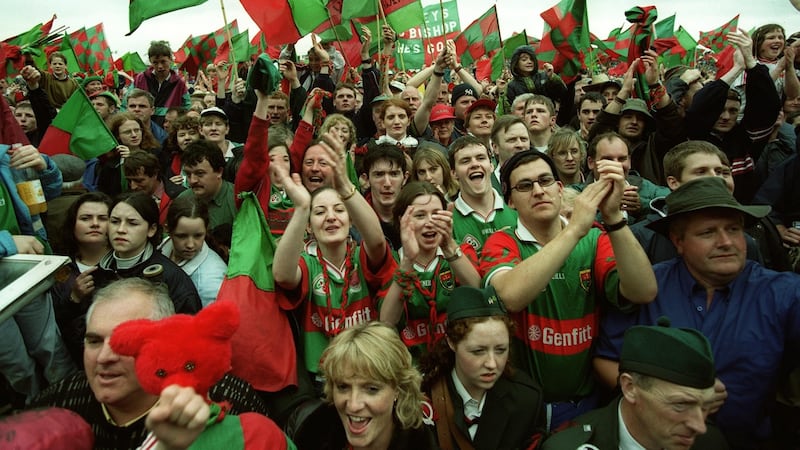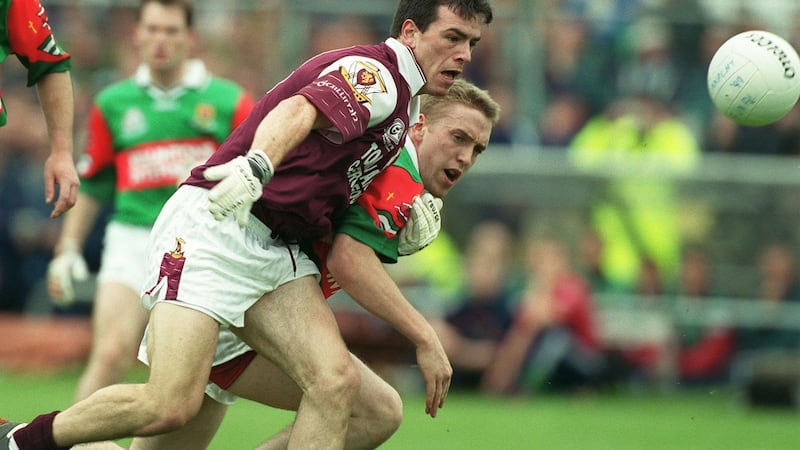July 18th 1999 and the 20th century may be cooling down but Tuam stadium remains the earth’s core so far as football rivalries go. It’s been a long time since Galway and Mayo has mattered so much. It is midsummer, even if it doesn’t feel like it. A hard rain is gonna fall. By nightfall, the Sunday Game phone lines will be hopping with irate fans saying they couldn’t get near the crowd despite having tickets.
“Oh big time. The crowd that day was unreal,” remembers Alan Roche, the sinewy Davitts defender who would make his debut in that afternoon’s final.
“You could feel the atmosphere during the minor game. The place was packed then, which was unusual to have the crowd in so early. Our team met in Breaffy House that morning and took a bus up. And the traffic down the road was unreal. We were on the wrong side of the road most of the way down. I know for a fact a lot of people with tickets just didn’t get in. I had a cousin over from Birmingham for that game. He didn’t even know I would be playing. He just wanted to see that game. It was just the rivalry between the teams just then.”
And for a couple of hours, at least, the Connacht theatre represented the power base of the national game. All the better that Galway, the All-Ireland champions, had their adversaries in Tuam stadium, then in the full glory of its reputation for anti-glamour. Tuam put the no into no-frills. The occasion was to be graced by the presence of President Mary McAleese. But in the week before the game, the Western Health Board found that the stadium was not fit for purpose: the toilets were blocked and, worse, the place had suffered a rat infestation. Pearse Stadium was still under redevelopment. Half a million punt had been invested in dragging Tuam forward and the county board worked furiously to make the problems right, hastily ordering a rake of portaloos. But it was an awkward position for the All-Ireland champions. As it was, they’d had a nervous escape against Sligo, who took them to a replay: 25,000 had shown up in Tuam for that. Plus, there was an unusual edge to this old rivalry.
Galway had watched Mayo lose the All-Ireland finals of 1996 and 1997 in grippingly theatrical fashion. Galway hadn’t even played in an All-Ireland final since 1983 but, under the assured guidance of John O’Mahony, came storming out of their sleepy hollow to win in dazzling fashion in 1998.
Freighted weekend
“For Galway to come in and show us, so to speak, well, that would have riled us a little bit,” conceded John Casey, in an interview with Pat Nolan last summer.
As well it might. So it felt like a freighted weekend. Internationally, the news was governed by the search for the missing aircraft flown by American scion John F. Kennedy Jr which had disappeared on a Friday evening flight to Nantucket. Locally, Galway’s redoubtable centre-back, John Divilly, had been involved in a minor car crash. It didn’t stop him playing but it was a worry. Gary Fahy, the resident full back, was forced out through injury. Mayo had their concerns, with Noel Connelly failing a fitness test on a hamstring injury on Sunday morning. That left the door open for Roche. It was quite the setting to make a championship debut.

“Yeah, I only heard I was in on the morning of the game. And I remember in the minor game the lads were all over the place on the field. It dried up a bit when it came towards our game and that helped a bit. But it was raining buckets.”
The underfoot conditions were the least of his concerns. He was marking Ja Fallon, reigning Footballer of the Year and a local god around Tuam. It wasn’t the easiest of assignments.
“It wasn’t! But I will say that we had done a bit of analysis on the Galway team. We pinpointed a few things and one of the things we zoned in on was Ja Fallon’s jink. We had our homework done. So they probably knew nothing about me but I knew plenty about him. Numerous lads had fallen for it over and over again. So the whole thing was when he did get the ball not to go for that shimmy. It is one of the things I remember John Maughan emphasising that day.”
The final score – 1-14 to 1-10 – does its best to disguise the drama of the game. A lot happened. Galway opened at lightning pace. James Horan responded and finished with 0-5 from play, his best scoring outing since the 1996 All-Ireland final. It was Roche who forced the turnover for the goal scored by David Nestor, who gave a memorable account of the moment afterwards.
“I sort of had an apparition as I was running in. I had a funny feeling it was going to hit someone’s hand and pop into my hand. I kept running and I don’t know whether it was James Horan or the fullback who got the touch but it bounced lovely and I just remember looking at the O’Neill’s logo and hitting it as hard as I could. Last year when I had a similar chance Martin Mc pulled off a massive save. If he had done that today who knows what would have happened.”
Almost immediately, Galway scrambled a retort at the other end of the field: a dropping ball skating through hands with Pádraic Joyce on hand to push it over the line. Back and forth it went until half time. At one stage, early in the second half, Galway led by 1-10 to 1-06. Mystifyingly, they would not score again and landed just a single point in the second half.
Collective unit
“It was a fair achievement when you have the likes of Joyce, Donnellan, Fallon and those,” says Roche. As a collective unit there wasn’t a better forward set in the game than them. Colm McManamon scored an amazing banana shot. I thought then: we are going to win this.”
And maybe, too, in the rain, the emotional exhaustion that came with landing an evocative All-Ireland championship finally caught up with Galway. Mayo finished strongly, introducing Ciarán McDonald who promptly scored a point, set up a goal chance and assisted with another point. And McDonald’s sodium light moment didn’t even register on the stats: an absurd, perfect cross field pass which he directed right into James Nallen’s hands for another goal chance. Nallen understandably grappled with it as though trying to handle lightning. It didn’t matter. Mayo were back. Afterwards, they chaired John Maughan across the soaked stadium. All was forgiven.

“I’m absolutely thrilled to bits. We took a bit of stick in the press and even locally after failing in 1996 and 1997 and losing in the first round last year. The players showed great resilience. There were mistakes made on both sides but we stuck with it and were able to call on Pat Fallon and Ciarán McDonald to turn the tide. We deliberately kept the team fresh this year and only togged out once this week. They have had a long winter as All Ireland champions and we had a bit of hunger today.”
The new Connacht champions went to the Ballinrobe Races on Monday - a post-championship tradition irrespective of whether they won it or not. What’s striking now, watching the grainy VCR footage, is the sense of shared pride about the fact that the west of Ireland game suddenly seemed to be in a good state.
“No excuses. The better team won,” concluded O’Mahony.
“I’d like to wholeheartedly congratulate Mayo. Last year I thanked them for two years they put in for Connacht football. This year I went in to wish them the best and to do their best to keep Sam Maguire this side of the Shannon.”
Ray Silke urged the Connacht board to start investing in underage teams so it wouldn’t take another 30 years for a team from the province to win an All-Ireland.
‘Tore us asunder’
The hopes that Mayo could double down on Galway’s defence dissipated when they met Cork in the semi-final.
“We got off to a great start but Philip Clifford tore us asunder. We had a good chance. We had that bit of experience and we had beaten the All-Ireland champions. We didn’t fear anyone but Clifford was absolutely on fire. We couldn’t control him at all at all. We got off to a brilliant start and maybe got a bit complacent then.”
Maughan would step down afterwards. And John Casey, the classy forward, was forced to retire with injury aged just 24. Others followed. Galway would bounce back spectacularly, narrowly missing out on the 2000 All-Ireland final before winning it all again in 2001 while Mayo would venture off towards more radical ventures in sound.
But that game in Tuam was the last game of knockout championship football between Galway and Mayo, the last time they got in another’s way. Twenty-one years have zipped by. Now, Horan and Joyce are on the sideline in the grander setting of Salthill. And it’s winner takes it all. Apart from the crowd – and, perhaps, the rats – it will feel like old times.












